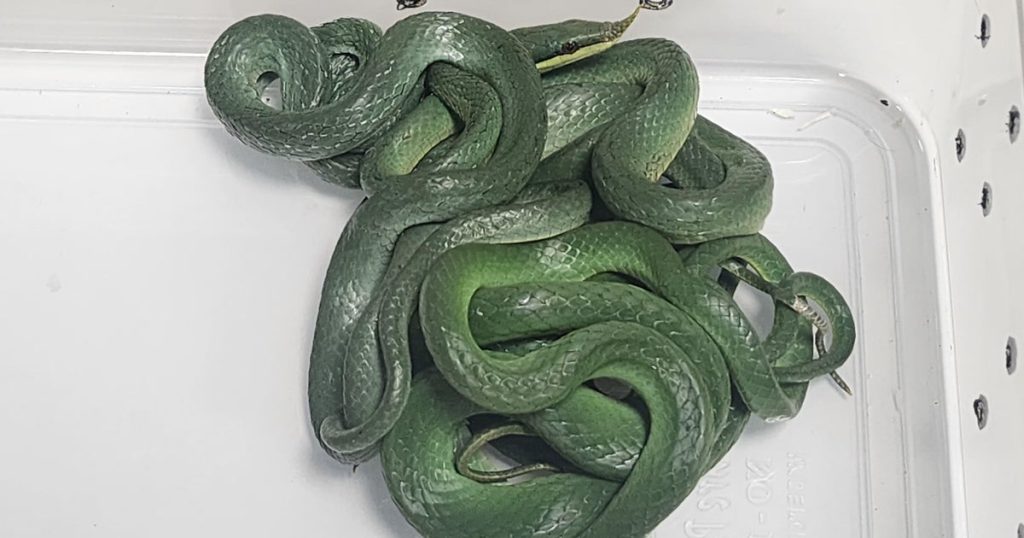Indian customs officials at Mumbai’s Chhatrapati Shivaji Maharaj International Airport have made headlines again after seizing a cargo of 16 live snakes from a passenger arriving from Thailand. This incident marks the third such wildlife smuggling attempt recorded this month alone, raising concerns about the increasing trend of illegal animal trafficking in the region. The passenger has been arrested, and customs authorities are currently investigating the case further.
| Article Subheadings |
|---|
| 1) Details of the Seizure and Arrest |
| 2) Types of Snakes and Their Market Value |
| 3) Previous Incidents of Wildlife Smuggling |
| 4) The Broader Impact of Wildlife Trafficking |
| 5) Measures to Combat Smuggling Activities |
Details of the Seizure and Arrest
On a recent Sunday, customs officials at Mumbai airport intercepted a passenger arriving from Thailand. During routine inspections, customs officers discovered a stash of 16 live snakes. The officers described the operation as a successful intervention against wildlife smuggling, stating,
“Customs officers foiled yet another wildlife smuggling attempt…”
. Following the seizure, the passenger was promptly arrested, and authorities confirmed that further investigations were underway to understand the scale and network of this operation.
Types of Snakes and Their Market Value
The cargo consisted of several species of snakes, including garter snakes, a California king snake, a rhino rat snake, and a Kenyan sand boa. These species are often sought after in the pet trade, appealing to exotic pet enthusiasts and collectors. According to specialists in animal trafficking, the market value of such snakes can vary significantly, depending on their rarity and breeding. Some of these snakes are non-venomous, or possess venom that is too weak to affect humans, making them more appealing for pet ownership. This trend has sparked concerns regarding the sustainability of wildlife populations, as demand continues to drive illegal trading.
Previous Incidents of Wildlife Smuggling
This latest seizure is not an isolated case. Earlier in June, customs officers intercepted another passenger attempting to smuggle dozens of venomous vipers from Thailand. Days later, officials apprehended a traveler carrying over 100 creatures, including various lizards and exotic birds like sunbirds. In an incident earlier this year, five endangered Siamang gibbons were also confiscated when found ingeniously concealed in a plastic crate within a passenger’s luggage. The increasing frequency of such seizures has raised alarms among wildlife conservationists and customs officials alike.
The Broader Impact of Wildlife Trafficking
Wildlife trafficking is driven by various factors, including the lucrative exotic pet trade. According to the wildlife trade monitoring organization TRAFFIC, over 7,000 animals—both dead and alive—have been confiscated along the Thailand-India route over the last few years. They highlighted that while most smuggling cases involve animals being trafficked out of Thailand, a staggering 80% of interceptions occur in India. TRAFFIC’s Southeast Asia director, Kanitha Krishnasamy, stated,
“The almost-weekly discoveries and diversity of wildlife en route to India is very troubling…”
. Such activities can have devastating effects on global biodiversity and ecosystem health.
Measures to Combat Smuggling Activities
In response to this troubling trend, customs authorities are implementing stricter regulations and heightened scrutiny at entry points, particularly those with established wildlife trafficking routes. Collaboration with international wildlife protection organizations and local enforcement agencies has become critical in combatting these illegal activities. This effort includes increased training for customs officials on recognizing the signs of wildlife smuggling and enhanced public awareness campaigns aimed at educating potential buyers about the risks involved in purchasing exotic pets. Such measures aim to reduce the demand and prevalence of illegal trafficking activities.
| No. | Key Points |
|---|---|
| 1 | The recent seizure at Mumbai airport involved 16 live snakes smuggled from Thailand. |
| 2 | The snakes included non-venomous species commonly sought after in the exotic pet trade. |
| 3 | Previous wildlife smuggling incidents have been on the rise, including the seizure of vipers and endangered gibbons. |
| 4 | Wildlife trade monitoring organizations have reported alarming trends in illegal trafficking in recent years. |
| 5 | Customs authorities are increasing efforts to combat wildlife trafficking through regulation and public awareness campaigns. |
Summary
The recent seizure of 16 live snakes at Mumbai airport marks a troubling trend in wildlife smuggling incidents, especially in relation to the exotic pet trade. Customs officials have ramped up efforts to combat illegal trafficking, emphasizing the need for greater awareness and stricter regulations. This ongoing issue raises significant concerns for both biodiversity and ecosystem health, ultimately highlighting the role of customs in safeguarding wildlife.
Frequently Asked Questions
Question: What types of snakes were seized at Mumbai airport?
The seized snakes included garter snakes, a California king snake, a rhino rat snake, and a Kenyan sand boa, which are commonly sought after in the exotic pet trade.
Question: Why has wildlife trafficking become a growing concern in India?
Wildlife trafficking has risen due to increased demand for exotic pets, with thousands of animals being smuggled along the Thailand-India air route in recent years.
Question: What measures are authorities taking to combat wildlife smuggling?
Authorities are implementing stricter regulations, enhancing customs inspections, and collaborating with wildlife protection organizations to combat illegal trafficking and raise public awareness.


